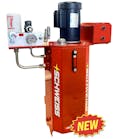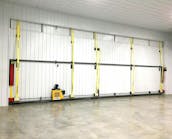With the world still grappling with the effects of the COVID-19 pandemic, passengers are acutely aware of the germs and other unseen risks around them as they travel.
It’s about more than being clean said Ruth Krieger, transport architecture director, HDR. Passengers in the COVID-19 age want a sense of cleanliness that has become something like a sense of security for them, and it is something they have been working on at upgrades to the Philadelphia International Airport (PHL).
“A lot of that has to do with lighting, smell and materiality. Things that we are doing in the restrooms using a lot of bright colored and light materials, and eliminating all the grout lines, and reducing odor,” said Krieger of achieve this sense of cleanliness.
Technology can go a long way to achieving this affect, such as adding UV lights to clean, or getting a disinfecting robot.
At the Honolulu International Airport (HNL), the airport was under construction when the pandemic struck and they incorporated the new need of cleanliness into their restroom designs.
“Our design was six figure minimum for the circulation area. Where easily, comfortably, you can have two opposite traffic, where carry-on luggage can pass each other, and stall width is three foot six by six feet. That's our typical stall size, which is much bigger than a conventional stall,” said Kaori Mikagi, senior project manager - architecture, HDR.
On the technological side, the airport made it so there were 15 air exchanges per hour for every restroom.
“Which is every four or five minutes, that air should be all exchanged completely. Restroom should be the safest in terms of not contaminating air comparing to the whole rooms, because the 15 air exchange is much aggressive than any other space in an airport. Also, we have the air dryer that is the HEPA filters, which traps 99.9% of the particles matter, and which definitely blocks the coronavirus particles. That kind of made them feel safer,” Mikagi said.
Smart, Durable Design
Krieger said that all bathrooms at PHL are being designed to incorporate smart technology.
“The airport is doing a pilot program to test a few different types of smart restroom software and options. Then whichever one they pick will be incorporated into our projects. So things that 10 years ago, you never thought that you would have in the restroom, like data lines and telephone lines, we now have,” she said.
At each stall there will probably be an occupancy sensor and a light, and they’ll have digital messaging signage at the exterior. She said that kind of technology is, “definitely being moved towards the forefront.”
“Then changing technology in the fixtures themselves, both Philadelphia and Honolulu have the hand dryers at the sink. So you have soap, water and hand dryer at each lavatory station. That's not really a new technology, but it hadn't been at either of these airports before, and I think it's getting put into airports now. It prevents people from dripping their wet hands all the over the floor, or the counter, when they go to reach for a paper towel,” Krieger added.
Smart technology in restrooms is still relatively new, however, and not all restroom fixtures may be able to have a “smart” counterpart. In that case, durability and functionality are preferred.
“At Philadelphia, they kind of decided that the functionality, maintenance, and durability of the restroom is more important than the smart function. If we pick a fixture based on durability and function, and it doesn't have smart restroom capabilities, they're okay with that. They would not ask us later to change our sink faucet or something like that if we picked one for a different reason,” Krieger said.
Mikagi said HNL is doing much of the same, choosing durability of items over smart capabilities.
“Then the materials are evolving too. There's a new material out there, now it's a large format tile. That tile is more common to use and that eliminates the grout and that's what we've been using. I'm sure other new restrooms have been adopting that material and no more ceramic tiles on floor,” she said.
It’s not just flooring whose durability can be increased – faucets, sinks, the floor material and even the walls behind the toilets – nearly everything, Krieger said, can have increased durability. Anything that see regular abuse can be buffed up.
“When I say durability, it's not just the wall materials, like the faucets get used thousands of times a day. When I was talking earlier, what Philadelphia said was, ‘Don't just pick the faucet that has the smart technology chip inside it, pick the one that's going to best hold up to our usage.’ If they had to sacrifice that piece of smart technology, they were willing to,” said Krieger.
At PHL, Krieger said, the airport has almost no tile.
“We have epoxy terrazzo floors, we have centered stone, large format, wall panels on the walls and behind the toilets. Centered stone is like a highly compressed porcelain material, it's much more durable than tile, and it has far fewer grout joints. It's going to collect less of bacteria and be less dirty,” she said.
Epoxy flooring also has a benefit of easier maintenance. It requires that the floors be resealed once or twice a year but lacks the grout lines that accumulate dirt and other debris.
“We actually met with the custodial and maintenance staff at Philadelphia, and they said that they were happy to do that maintenance because it's so much easier to keep the epoxy terrazzo floors clean than it is the tile,” said Krieger. “If you think of a tile floor, even if you used the dark colored grout, all the dirt doesn't stick to the tile it sticks to the grout. And then you have to scrub that clean. But with, with epoxy terrazzo, you don't have to do that. Same with wall tile, all of the dirt and bacteria collect in the grout. If you don't have that, it's much easier to keep clean, so maintenance becomes easier.”
Simplifying maintenance at HNL, Mikagi said that each toilet and urinal has been designed with a self-powered system strong enough to generate the power needed to set the next trigger, requiring no electrical work.
“We completely eliminated electrical trade out of the chase room. That's simplifying the maintenance there. It's basically dealing with the water only in chase room,” she said.
As restroom upgrades continue at both airports, PHL is updating 30 restrooms and HNL 38.
By the Numbers
The question remains, when it comes time to decide whether or not to, how does an airport decide what to upgrade or make more durable and where? How can they make sure the most passengers are feeling hygienically secure? By simply measuring them.
“Passenger Flow systems offer a clear view, both, real-time and predictive, of how and when travellers use facilities. With this insight, operators can more easily plan resourcing to match high-demand periods, ensuring there are sufficient employees to manage cleaning, and directing them to high-usage areas,” said Christian Bugislaus Carstens, PR and digital marketing manager, Veovo.
Veovo’s passenger flow systems work by a combination of sensors, cameras and other data sources to measure and analyze passenger movements within the airport on a per-flight level.
“The data collected feeds into the cloud-based analytics platform, which bundles analytics, sensor data and rich visualizations to provide historical, live and predicted integrated flight, resource and passenger flow insights for each flight. The platform delivers metrics such as actual vs forecast wait times, occupancy, and passenger throughput for each area in which sensors are deployed, and/or throughout the airport,” said Carstens.
By analyzing the data, both live and predictive data can be ascertained, per flight and on restroom usage.
“With this data, the airport can use the insights to manage the situation in real time, ensuring adequate frequency and timing of cleaning. They can also redirect passengers to areas not currently occupied, by using signage or apps, thereby minimising the risk of crowding. With predictive data, operators can manage the flow of people to and from facilities in advance, as well as plan staffing resources and scheduling to prevent shortages in restroom management,” said Carstens.






